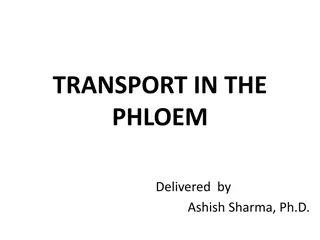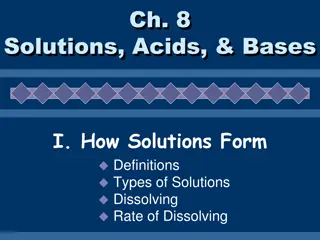Introduction to Physical Science
Explore the world of solutions in physical science through this detailed presentation by Robert Wagner. Learn about the basic properties of solutions, different types of solutions, the formation of solutions, electrolytes, and much more. Understand the concepts of solutes, solvents, homogeneity, and
0 views • 9 slides
Electrolyte and Metabolic Disturbances in the Critically Ill
Dr. Srilekha Ammapalli discusses the cations (sodium, potassium, calcium, magnesium) and anions (chloride, bicarbonate, phosphate, lactate) involved in electrolyte and metabolic disturbances in critically ill patients. The physiology, causes of abnormalities, diagnosis, evaluation, and management of
2 views • 104 slides
Understanding Water Relationships in Plant Physiology
Water plays a crucial role in the physiology of plants, with most absorbed water being translocated to leaves and lost through transpiration and guttation. While essential for turgidity and mineral translocation, plant water use is often inefficient. Transpiration is the primary mode of water loss,
3 views • 22 slides
Understanding Water Potential and Solute Concentration in Biological Systems
Explore the concept of water potential and solute concentration in cells through diagrams and equations. Learn about hypertonic, hypotonic, and isotonic solutions, and how water movement is affected by solute concentration differences. Discover how adding solutes affects water potential and the dire
0 views • 19 slides
Transport in the Phloem: A Detailed Overview by Ashish Sharma, Ph.D.
The phloem plays a vital role in transporting sugars and organic materials throughout plants. This system involves various specialized cells like sieve elements, companion cells, parenchyma cells, and phloem fibers. Mature sieve elements lack certain organelles and have non-lignified cell walls, mak
7 views • 32 slides
Free Science Education Resources on Science Prof Online (SPO)
Science Prof Online (SPO) is a valuable free science education website offering fully-developed Virtual Science Classrooms, science-related PowerPoints, articles, and images. It serves as a comprehensive resource for students, educators, and anyone interested in science. Explore practice test questi
0 views • 17 slides
Understanding Translocation in the Phloem
This lecture explores the process of translocation in the phloem, supported by evidence from studies such as aphid experiments, ringing experiments, and the use of radioactive isotopes. It delves into the materials translocated in phloem sap, including water, sucrose, non-reducing sugars, nitrogen c
5 views • 18 slides
Understanding Column Chromatography Methods
Column Chromatography (CC) involves separating solutes based on different mechanisms within a packed column with a mobile phase. The five major types of CC are adsorption, partition, ion exchange, molecular exclusion, and affinity chromatography. Each type utilizes specific stationary and mobile pha
0 views • 11 slides
Understanding Solutions and Concentration Units
Explore the world of solutions, the role of solvents and solutes, why solutions form, different concentration units like molarity and molality, calculations involved, colligative properties such as vapor pressure lowering, and how Raoult's Law explains changes in boiling and freezing points in solut
0 views • 13 slides
Understanding Concentration in Solutions
Solutions involve the dissolution of solutes like salt or sugar in solvents such as water, resulting in different concentrations. This concentration can be expressed as moles per liter, known as molarity. By calculating the amount of substance in moles using solution volume and concentration, you ca
0 views • 8 slides
Understanding Solutions and Solubility in Chemistry
Explore the concepts of solutions, solvents, solutes, and solubility in chemistry through investigations with various substances and solvents. Learn how to differentiate between dilute, concentrated, and saturated solutions, measure solubility, create solubility curves, and understand crystallizatio
0 views • 36 slides
Understanding Solutions: Definitions, Types, and Rate of Dissolving
Solutions are homogeneous mixtures of solutes dissolved in solvents. They can be saturated, unsaturated, or supersaturated based on solubility. The process of dissolving involves solvation, and factors like stirring, particle size, and temperature affect the rate of dissolving.
0 views • 53 slides
Understanding Solvent Effects in Organic Chemistry
Different solvents can have varying effects on chemical reactions by influencing solubility, stability, and reaction rates. Solvents can control the pathway towards forming either thermodynamic or kinetic products based on their selection. Solutes dissolve based on intermolecular interactions with s
0 views • 6 slides
Understanding Analytical Chemistry: Solutions and Miscibility
Explore the fundamentals of solutions in analytical chemistry, including the types of solutions, role of solutes and solvents, and the concept of miscibility. Learn about the six types of solutions based on phases, the general rule of miscibility, and the solution process involving dissolution and c
0 views • 17 slides
Understanding Solution Composition in Chemistry
Exploring the properties of solutions, this content delves into measuring solution composition using techniques like molarity, mass percent, and mole fraction. Through examples, it explains how to calculate the weight percent of solutes in solutions, offering a comprehensive guide on understanding e
0 views • 66 slides
Exploring Ecosystem Dynamics: Environmental Systems Study
In this Environmental Systems study, students delve into identifying native plants and animals using a dichotomous key, assessing their roles within local ecosystems, and comparing them to other biomes. They also analyze abiotic cycles such as rock, hydrologic, carbon, and nitrogen cycles, and evalu
0 views • 40 slides
Techniques for Separating Mixtures: A GCSE Guide
Explore various separating techniques such as chromatography, distillation, filtration, and crystallization for different mixtures in a GCSE science context. Learn how to separate substances like solutes, solvents, liquids with similar boiling points, magnesium, salt, and more. Engage in a challengi
0 views • 5 slides
Gas Chromatography: Behavior of Solute, Advantages, Disadvantages, and Applications
Gas chromatography involves the chromatographic behavior of solutes in various ways such as retention volume, retention time, and partition coefficient. It offers advantages like good separation, short analysis time, and universal detectors for organic compounds. However, there are disadvantages suc
0 views • 15 slides
Understanding Adsorption Process in Physical Pharmacy Lab
Adsorption is a significant process in physical pharmacy involving the attachment of solutes or gaseous molecules onto the surface of a solid. This process can be strong or weak depending on the forces between the solid surface and the gas/solute. Types include physical (reversible) and chemical (ir
0 views • 16 slides
Understanding Sterile Pharmaceutical Products Development
Sterile products are dosage forms free of viable microorganisms, crucial for parenteral administrations to ensure therapeutic efficacy and patient safety. This article covers the importance of sterile products in the pharmaceutical industry, the development objectives, different routes of administra
0 views • 31 slides
Understanding Parts per Million (PPM) in Solutions
Explore the concept of Parts per Million (PPM) in solutions, how it differs from percentages, and practice calculations to express solubilities in PPM. Learn to calculate PPM for different scenarios involving solutes dissolved in solvents, such as gases in water. Master the formula and application o
0 views • 6 slides
Understanding Solutions and Solubility through Experiments
Explore the concept of solutions and solubility through various investigations and experiments. Learn about solvents, solutes, and solutions, and discover how temperature affects solubility. Use the particle model to explain the process of dissolving and understand the properties of saturated soluti
0 views • 10 slides
Chemistry Study Materials and Practice Questions
This collection of chemistry study materials includes information on reactions, solubility, electrolytes, and solution stoichiometry. Practice questions cover classifying solutes, predicting solubility of salts, writing ions produced in water, and determining precipitates in reactions. Includes a mo
0 views • 15 slides
Understanding Solutions and Concentration in Chemistry
Explore the concepts of solutions, solutes, solvents, concentration, and molarity through engaging activities like the "Bearly Alive" experiment and discussions on saturated solutions. Learn to define and calculate molarity, and understand how compounds behave in solution. Get ready for hands-on lab
0 views • 13 slides























